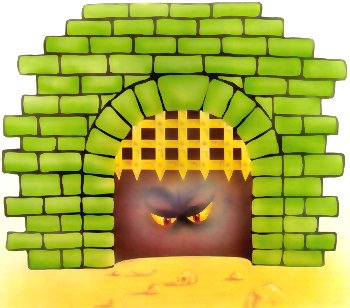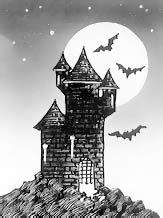| adventure games |

Phil Garrett tries to guide you through the world of adventure games in this the first of two fascinating articles on the subject
IF YOU enjoy delving into rat-infested dungeons, crawling through dimly-lit caves, and wandering round long-abandoned mine-workings, Adventure is for you. Your powers of memory, logic and patience are tested to the limit as you take life-and-death decisions in your search for fame and riches - all without leaving the comfort of your chair and with only one risk to your physical well-being. That is a severe headache after bashing your head against the wall when your latest seven-minute Adventure failed to load for the fifth time.
Adventure is a role-playing game, where after being told about your immediate environment, you can enter commands such as "Go west", "Take keys", "Throw knife". The computer will then provide an appropriate response, such as a new room description, "You missed", or some other message. You many encounter fabulous treasures, or perhaps only mundane objects, although they may, if used correctly, be the key to a still greater fortune.
You will probably need to make a map as you proceed to have some chance of re-tracing your steps to the entrance. Natural - and unnatural - hazards abound to prevent your escape, and it should take many delvings to discover all that an Adventure contains.
Computer Adventures are a surprisingly recent invention, the original having been written on a mainframe in 1976 by William Crowther and Don Woods at Stanford University in the U.S. It is a remarkable achievement when you consider that, until recently, Fortran, the language they used, had none of the string-handling facilities of Basic. Until two years ago, Adventure was strictly the preserve of computer professionals but the growth of micros has resulted in far wider use.
For this review of Adventure games for the ZX-81, I decided to look at every Adventure and Adventure-type game I could find. They vary a great deal, from the traditional descriptive type to real-time graphics games, so I have tried to judge each on its merits rather than compare one to another.
My employer told us recently to take Adventure off the computer at work, as we were running out of disc space. That being such an unreasonable instruction, I checked how much memory it used and found that the program and the data it required occupied more than a quarter of a million bytes. So, not surprisingly, all the ZX-81 games require 16K RAM packs.
The logical program to start with is the Abersoft Adventure, which attempts openly to pack as much of the Crowther and Woods' original into 16K as possible. As I was usually hopelessly lost in the maze in the Adventure at work, I was hoping that perhaps lack of memory had forced them to omit the maze from the Sinclair version. Not a chance; on the first attempt I went straight into it like a homing pigeon. The maze seems like quicksand; the more you struggle to escape the deeper you sink.
At that point I asked a friend who had acquired a good knowledge of the original Adventure to try from the beginning. She found that all the locations and objects were in the correct places, although the location descriptions were shorter. She even discovered a new area she had not entered previously.
The program is written in 13K of machine code and 1½k of Basic, with more than 70 words which can be recognised as commands or objects, and a large number of locations. The game has been written with remarkable efficiency; location descriptions are built-up from individual words and phrases rather than stored en bloc. Being machine code, the program is very fast. At any time you can find your score and also save your current position on tape to continue later.
At £10, it is an expensive program but it is a remarkably good version of the original Adventure and well worth the money if you want to see what sparked the entire process.
Hilderbay is best known for being the "serious" software company, supplying business programs, but it has also forayed into the world of games and its Gold is a non-graphics 13K Adventure written in Basic. The object is to search for gold hidden in a network of caves and mines in the Yukon. All instructions are entered as a single letter, O for Open, G for Get, including references to objects such as Gold and Keys.
There is a sizeable network of logically-connected caves and rooms, although there are few objects. If you manage to find the gold, things change mysteriously and I have not been able to extract the goodies yet. At any time you can learn your score and there is an added bonus if you manage to escape with the treasure.
Hilderbay is offering a 48K Memotech RAM pack to the person who achieves the highest score before the end of July but I do not think my 46 will be in the running.
At £8, with a word game included, Gold is reasonable value but could have been better with a few more objects - and word rather than letter input.
Bug Byte offers two Adventure-type games, the latest of which, Dictator, is a brilliant simulation of a banana republic; since it has no locations, no objects, and no movement of any kind, it is not an Adventure so I have not included it.
The other is The Damsel and The Beast which is a graphics-only 9K Basic game. The setting is an unlit palace of 35 rooms, containing a beast for bashing, a damsel for rescuing, and a few holes into which you can fall. That calamity should be avoided by using the limited supply of torches available and you are also provided with some powerful clubs if you should wish to knock down a wall or kill a monster.
After being set-up randomly, the layout of the rooms does not change, so a logical approach is rewarded. Movement, and the use of clubs and torches, is by single-letter commands and the beast continues to move of its own accord while you decide what to do.
The game is not desperately fast and while in progress there is little to look at, although you are provided with a map of the events at the end. There is no score given but there are three levels of play and I found even the easiest of them difficult enough. It is not a game for Space Invader addicts but if logic and patience are your virtues, it is one to consider. It is on the expensive side at £6.50.
Quest from Serious Software is clearly based on the non-computer Dungeons and Dragons fantasy role-playing game, with the computer-man pitting his strength, constitution and dexterity against wandering monsters. It is a non-graphics game written in 12½K of Basic and is made up essentially of vampires, rats, werewolves and suchlike. If you can keep the fiends off your back for long enough there are potions, keys and other objects to be found and substantial amounts of treasure to be acquired.
Movement and fighting is done by single-key input, which can be confusing, since the same key may mean different things depending on what is happening around you, e.g., F may mean move Forward or Fire magic arrow. You can always ask for a status report and, if you can put together sufficient treasure, the delights of different levels are offered.
My reactions cannot cope with this one but at £5.95 for Quest plus a Star Trek, Mastermind and Reversi included, it is good value for the nimble-fingered.
Adventure from Simpson Software has its origins in the Crowther and Woods' original but is set in a mythical castle containing evidence of an extraordinary mixture of living beings - hobbits, dwarfs and pirates, among others. It is a non-graphics adventure with 25 logically-connected locations written in 11½K of Basic.
The method of processing instructions entered by the player is unusual; instead of checking for individual words as most Adventures do, the input string is compared in a large series of if-then statements. That makes it reasonably fast, but means there is a very limited vocabulary; e.g., you must refer to a Ming vase, not just a Vase. One weak point - answers to Yes or No questions are not validated, so a NEWLINE stops the program.

There are plenty of treasures dotted about, a hidden lower level, and a maze into which you can fall. A score is kept, though my earliest attempts ended in negative scores. It is an unpretentious program, reflected in its price of £3. It would make a good introduction to anyone new to the concept of Adventure who wants to start with something reasonably simple.
Phipps Associates offers three complete Adventures on one tape, plus a detailed instruction program. All the games are written in 15K of basic and the first two are based on Trevor Toms' Adventure-writing program from his book The ZX-81 Pocket Book. Several months ago I typed-in the program and was impressed but I felt that it would be too difficult to use and that the range of locations and objects would be too limited. The Phipps tape proved me wrong.
Greedy Gulch is set in a Wild West ghost town with more than 20 locations, plenty of objects which have to be collected and used in a logical sequence, and a vocabulary of more than 50 words. It is not particularly fast - around 10 to 12 seconds to process instructions - but it has some graphics in the form of a simple but useful map. There is no score but to compensate there is a hint feature.
The second is the non-graphics Pharaoh's Tomb which has more than 60 locations, made possible by giving only short descriptions, and more than 20 objects. It runs slightly faster than Greedy Gulch, despite an even larger vocabulary, and has a score but no hint feature.
It shares with the first program some poor spelling, although. Phipps Associates is by no means the only culprit where that is concerned.
Magic Mountain has witches, wizards and spells, and an assortment of mystified objects. It also has a maze which, as usual, I discovered very quickly. It took me a solid guilt-ridden hour of cheating to get out, despite using one of the hints available in the form of cryptic crossword-type clues. All three programs are excellent Adventures and at £5.95 complete they are undoubtedly the best value for money of all the Adventures I have seen so far.
Next month I will examine 12 more programs, including the three machine code Adventures from Artic.